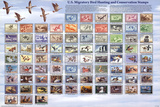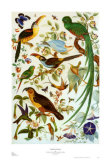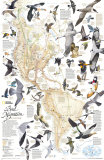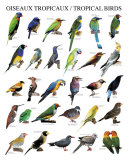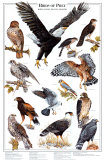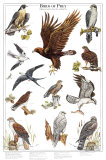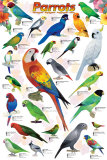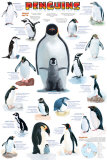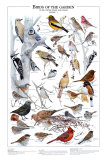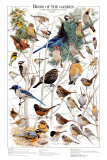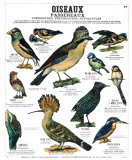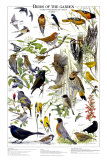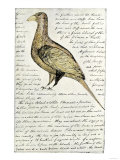|
|
Birds & Ornithology Educational Posters, Art Prints & Charts
for the science and social studies classrooms, home schoolers, theme decor.
|
science > zoology > BIRDS 1 | 2 | state birds < social studies posters
|
|
Birds belong to the class of Aves, warm-blooded, egg-laying, feathered vertebrates with forelimbs modified to form wings. Ornithology (Gk. ornis = bird + logos = word), a branch of zoology, is concerned with the scientific study of birds. Birds are very important to humans: wild and domesticated fowl provide meat, eggs and feathers; falcons have been trained for hunting, cormorants for fishing, and homing pigeons were used for quick communication.
Bird images and characteristics are present in world mythologies and traditions - Noah understood the great flood was over when a dove returned with an olive branch, the owl is associated with wisdom, and the phoenix is a legendary bird symbolic of immortality and resurrection.
|
|
| Anseriformes: waterfowl |
Opisthocomiformes: hoatzin |
| Apodiformes: swifts and hummingbirds |
Passerines: perching, song birds |
| Caprimulgiformes: nightjars and allies |
Pelecaniformes: pelicans & allies |
| Cathartiformes: New World vultures |
Piciformes: woodpeckers & allies |
| Charadriiformes: gulls, button-quails, plovers |
Phaethontiformes: tropic birds
|
| Ciconiiformes: storks and allies |
Phoenicopteriformes: flamingos |
| Coliiformes: mousebirds |
Podicipediformes: grebes |
| Columbiformes: doves & pigeons |
Procellariiformes: albatrosses, petrels, & allies |
| Coraciiformes: kingfishers & allies |
Psittaciformes: parrots & allies |
| Cuculiformes: cuckoos & turacos |
Pteroclidiformes: sandgrouse |
| Falconiformes: falcons, eagles, hawks & allies |
Sphenisciformes: penguins |
| Galliformes: fowl |
Strigiformes: owls |
| Gaviiformes: loons |
Trogoniformes: trogons |
| Gruiformes: cranes & allies |
|
|
• “I value my garden more for being full of blackbirds than of cherries, and very frankly give them fruit for their songs.” ~ Joseph Addison
• “One swallow does not make a summer.” ~ Aristotle
• “No bird soars too high if he soars with his own wings.” ~ William Blake
• “When thou seest an eagle, thou seest a portion of genius; lift up thy head!” ~ William Blake
• “The very idea of a bird is a symbol and a suggestion to the poet. A bird seems to be at the top of the scale, so vehement and intense his life. . . . The beautiful vagabonds, endowed with every grace, masters of all climes, and knowing no bounds – how many human aspirations are realised in their free, holiday-lives – and how many suggestions to the poet in their flight and song!” ~ John Burroughs
• “I hope you love birds too. It is economical. It saves going to heaven.” ~ Emily Dickinson
• “I know why the caged bird sings, ah me, when his wing is bruised and his bosom sore; when he beats his bars and he would be free, it is not a carol of joy or glee, but a prayer that he sends from his heart's deep core.” ~ Paul Laurence Dunbar
• “You can know the name of a bird in all the languages of the world, but when you're finished, you'll know absolutely nothing whatever about the bird... So let's look at the bird and see what it's doing — that's what counts. I learned very early the difference between knowing the name of something and knowing something.” ~ Richard Feynman
• “You cannot fly like an eagle with the wings of a wren.” ~ William Henry Hudson
• “I once had a sparrow alight upon my shoulder for a moment, while I was hoeing in a village garden, and I felt that I was more distinguished by that circumstance that I should have been by any epaulet I could have worn.” ~ Henry David Thoreau
• “Those little nimble musicians of the air, that warble forth their curious ditties, with which nature hath furnished them to the shame of art.” ~ Izaak Walton
|
|
|
|
|
Audubon Fantasy
John James Audubon was an ornithologist, naturalist, and artist who painted, catalogued, and described the birds of North America.
|
|
|
|
|
|
|
Bird Migration Map - the Americas: sixty-seven full illustrations, printed at a scale of 1 inch to every 315 miles.
The Mystery of Migration -
Bulging with fat for fuel, congregations of blackpool warblers wing south over the Atlantic each autumn from the coasts of New England and eastern Canada. Some pause at Bermuda or other islands, but most fly nonstop to South America – a journey of nearly 2,5000 miles at a maximum altitude of 21,000 feet. The black poll warbler is smaller than a sparrow.
The arctic tern, a much larger bird, migrates from near the top of the world to the bottom – Antarctica. Counting the return flight in spring, it may travel 25,000 miles, the Earth's circumference.
Scientists don't know exactly how the migrating birds find their way over long distances, but they are discovering that birds tune in to an astonishing variety of sensory cues that may be used for navigation.
Observers have long theorized that migrants use mountain ranges, rivers, and coastlines for guidance. Scientific research suggests that some birds may also set their courses by the sun, by the patterns of stars, even by the lines of force in earth's magnetic field, perhaps in combination with gravity.
Some birds respond to ultraviolet and polarized light and can hear low-frequency sound that travels thousands of miles. Thus upland sandpipers flying high above the Mississippi conceivably could hear surf from both the Atlantic and Pacific Coasts.
How the migrants process these cues is a mystery. But the incredible facts remain: The birds know where they are, and they know where they are going. - more details
• more map posters
|
|
|
|
|
|
|
The “tropics” is the region circling the planet Earth that is centered on the equator and limited by the the lines of latitude called the Tropic of Cancer (23°27'N) and the Tropic of Capricorn (23°27'S). The tropics experience little seasonal change and climate is characterized by high temperatures, humidity, and rainfall, though the Andes Mountains and the Sahara Desert both lay in the tropic zone and have the extremes of cold, hot and dry.
[birds listed in this poster]
|
|
|
| Strigiformes: owls
|
|
|
|
|
|
|
|
|
Thomas Jefferson to Meriwether Lewis
"... Your observations are to be taken with great pains & accuracy, to be entered distinctly & intelligibly for others, as well as yourself ...
• ... objects worthy of notice will be ... the animals of the country generally, & especially those not known in the US. ...
• Lewis & Clark posters
|
|
previous page | top | BIRDS 1 | 2 | state birds
|
|
I have searched the web for visual, text, and manipulative curriculum support materials - teaching posters, art prints, maps, charts, calendars, books and educational toys featuring famous people, places and events - to help teachers optimize their valuable time and budget.
Browsing the subject areas at NetPosterWorks.com is a learning experience where educators can plan context rich environments while comparing prices, special discounts, framing options and shipping from educational resources.
Thank you for starting your search for inspirational, motivational, and educational posters and learning materials at NetPosterWorks.com. If you need help please contact us.
|
|
|














